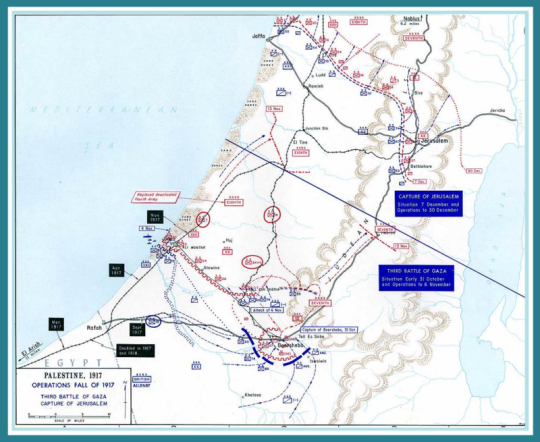
Palestine, 1917/18.
"The first definitely Irish Division to exist in the British Army,” the 10th, having fought at Gallipoli and Macedonia, was in Palestine by early 1917, as part of the 20th Corps. Although the safety of the Suez Canal had been ensured, political pressure for an advance into Palestine, without adequate resources and administrative support, resulted in General Murray’s checks at Gaza in March and April 1917. He was replaced by Allenby, who demanded fresh troops, if he were to fulfil Lloyd George’s demand for “Jerusalem by Christmas – as a present to the British Nation.”
The 10th Irish Division (nominally GHQ troops) accordingly took part in the Third Battle of Gaza – in fact, at Beersheba, on the left flank of the Turkish defences. After some post Macedonia respite and training, the Irish regiments were ready for the fray in an entirely new type of theatre – one of desert and hills with few communications and little water; maintenance, largely by animal transport, including camels and donkeys, assumed new proportions.
General Allenby’s intention was to attack the Turks at Gaza and at Beersheba and, after capturing Beersheba, to make an enveloping attack on the left flank of the enemy’s main position in the direction of Sheria and Hureira; the 20th Corps (General Chetwode) and Desert Mounted Corps would first seize Beersheba – important for its water supply (31st October).
A number of Irish units served in Palestine and Transjordan during 1917 and 1918, including all three Brigades of 10th (Irish) Infantry Division, which had been partially reorganised since its time at Gallipoli and Salonika and by the middle of 1917 comprised: .
29th Brigade.
1st Bttn, Leinster Regiment.
6th Bttn, Royal Irish Rifles.
5th Bttn, Connaught Rangers.
6th Bttn, Leinster Regiment.
30th Brigade.
1st Bttn. Royal Irish Regiment.
6th Bttn. Royal Munster Fusiliers.
6th Bttn, Royal Dublin Fusiliers.
7th Bttn, Royal Dublin Fusiliers.
31st Brigade.
2nd Bttn, Royal Irish Fusiliers.
5th Bttn, Royal Inniskilling Fusilliers.
6th Bttn, Royal Inniskilling Fusiliers.
5th Bttn, Royal Irish Fusiliers.
10th (Irish) Division was "Indianised" during 1918 and, from May onwards, only the three Regular Irish battalions remained with the Division and the other battalions were disbanded or sent to the Western Front:
1st Bttn, Leinster Regiment, 29th Brigade.
1st Bttn, Royal Irish Regiment, 30th Brigade.
2nd Bttn, Royal Irish Fusiliers, 31st Brigade.
In addition, 2/18th London Regiment (2nd Bttn London Irish Rifles) arrived in Egypt during June 1917 with 60th (2/2nd London) Division, which was involved throughout the campaigns of late 1917/early 1918. After suffering heavy casualties in the spring of 1918, the Division was also "Indianised". During July 1918, the 2/18th Londons was disbanded with most of its men joining the remaining Irish battalions remaining in the Miiddle East with 10th (Irish) Division.
Source: "A History of the Irish Soldier", Brigadier AEC Bredin DSO MC DL.
Link to General Allenby's account of the Palestine campaign from July 1917 to October 1918.




